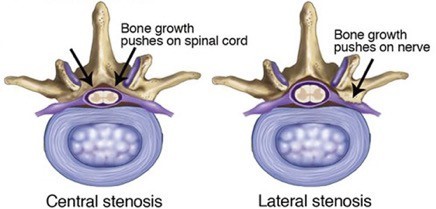Spinal stenosis is a narrowing within the vertebrae of the spinal column that results in too much pressure on the spinal cord (central stenosis) or nerves (lateral stenosis). Spinal stenosis may occur in the neck or in the low back. Spinal stenosis may result in such symptoms as, pain, numbness, tingling, or weakness in your arms and shoulders, legs, or trunk. Occasionally, problems with bowel or bladder function may be experienced. Your symptoms might get worse with walking and improve with sitting and resting. In most cases, symptoms of spinal stenosis can be effectively managed with physical therapy and other conservative treatments. Only the most severe cases of spinal stenosis need surgery or more aggressive treatments. The most common causes of spinal stenosis are related to the aging process in the spine. Normal aging and wear and tear can result in a flattening of the disks that provide space between each set of vertebrae. This narrowed space allows less room for the nerve to exit from the spinal cord, and sometimes pieces of disk material cause pressure on the nerves. Those with osteoarthritis are also susceptible to spinal stenosis. Osteoarthritis is a deterioration of the cartilage between joints. In response to this damage, the body often forms additional bone (called “bone spurs”) to try to support the area. These bone spurs might cause pressure on the nerves as they exit the spinal canal.
